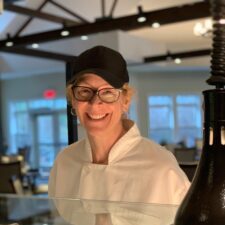How Senior Care Communities Can Keep Dining Menus Fresh and Exciting
Meals are a very important part of the senior care experience, but it’s easy for dining menus to become repetitive. Fresh and varied menus enhance resident satisfaction and enjoyment while also promoting better nutrition and wellness. I Advance Senior Care spoke with three experts about practical ways senior care communities can keep dining menus fresh and exciting.
The Value of Menu Variety

Lindsay Scaringella, MS, RN, LDN at CareOne
Lindsay Scaringella, MS, RN, LDN at CareOne, explains that menu variety is important for several reasons. “Most importantly, as we age, our nutritional needs become more individualized to our chronic health conditions. It is important that our diets align with the right macro and micronutrients,” she explains. For example, diets low in sodium are important for those with heart conditions. “Providing a variety of meals that are less processed and focus on whole foods is key to managing a healthy lifestyle and reducing health complications,” Scaringella says.
Goodwin Living’s Culinary Innovation & Development Chef, Brian Patterson, notes that menu item and ingredient variety can be mentally, emotionally, and intellectually stimulating and satiating. “Variety can also refer to where ingredients are sourced,” he notes. “More and more, residents take an interest in where their food comes from. The narrative behind food is increasingly relevant to how we enjoy and care about what we eat. We welcome farmers and wine makers to our campuses to give presentations and tastings, and we are planning field trips to local farms, breweries, and wineries.”

Brian Patterson, culinary innovation & development chef at Goodwin Living
Patterson explains that he’s also seen increased resident desire for greater cultural diversity through culinary experiences. This includes ingredients and techniques tied directly to authentic styles of cuisine, as well as more immersive dining experiences like chef’s table and wine dinners.
Strategies to Offer Menu Variety While Staying Within Budget
To offer variety while staying within budget, Patterson encourages senior care communities to adopt several strategies. “Working with broadline vendors to source bulk deals on sensibly raised, processed, and packaged foods is one way of getting the best deal,” he says. “Pair more expensive items with ingredients that cost less to achieve a well-priced meal or offer them with an upcharge to the regular dining allowance or cycle menus.”
Local purveyors can also help communities stay within budget. “Demand for locally sourced food can lead to developing relationships with local purveyors who can offer potential for savings by dealing directly with local producers that feature uniquely local ingredients,” says Patterson. “Consider working pop-up experiences into your menu schedule, which makes it possible to serve up special experiences and foods like a Hawaiian Luau, Spanish Tapas, Asian Noodle House, German Wurst and Beer Garden.”

Kate Hays, director of dining services at Wake Robin
Kate Hays, director of dining services at Wake Robin, says that the community creates menu variety by running a daily menu as well as an “always available” menu with plenty of extra offerings and choices. “Our daily menu offers a soup and appetizer du jour, a choice of two animal-based and one plant-based entrees, a starch and vegetable du jour, and a dessert du jour,” she says. The always available menu includes a vegetarian soup, a choice of additional salads, entrées, vegetables, and starch. “We also offer unseasoned griddled chicken, salmon, and tofu for those looking to avoid added sodium or address other health or nutritional issues, or who are just unhappy with the daily menu offerings. To create additional menu choices, residents are invited to use a sauce off one of the daily entrees to customize their unseasoned protein of choice if they desire,” Hays notes.
Scaringella explains that the CareOne food service team collaborates to create a varied menu while staying within budget. “Buying foods within season is a great way to save money while getting the best tasting produce,” she says.
She notes that it’s also important to focus on limiting food waste to maximize the food budget. “Educating staff to encourage patient food intake and keeping record of meals that are a ‘hit’ can help reduce waste and save money.”
How to Establish a Dialogue Between Residents and Culinary Services
Resident input is an essential element in creating menu variety, and there are many ways to capture that input. “In addition to emails and hallway conversations with residents, Wake Robin has comment boxes in our dining rooms, a Suggestions and Concerns Committee, a resident council meeting that addresses dining issues, and a Dining Advisory Group,” says Hays. She notes that the channels give residents a chance to share their thoughts and engage with the culinary team.
CareOne in Newton, Massachusetts, holds quarterly resident counsel meetings with the activity group. Residents have the chance to provide input on what they might want to see on the menu during the coming months. “Getting positive and negative feedback from the residents can help reduce food waste and save money within the food service budget,” Scaringella says.
Patterson notes that residents are very involved in informing Goodwin Living community menu choices. Campuses encourage resident input in several ways:
- Recipe contests in which residents submit recipes and the chefs choose their favorites and feature them on the menus, along with the narrative or story behind the recipe.
- Residents often bring herbs and vegetables from their garden boxes to the chefs.
- Cooking demonstrations and hands-on cooking classes stimulate resident input.
- Chefs and residents dine together. This is a great way for chefs to receive input and understand the aspirations of residents.
- The life enrichment team sponsors Culinary Passport Trips, monthly outings to local restaurants that are driven by resident requests and preferences.
- Goodwin Living hosts celebrity bartender nights that feature a team member or resident and their preferred cocktail.
Additionally, Goodwin Living encourages dialog between dining services and residents with tools including direct engagement, a comment book in each venue, survey cards, and an email forum for open discussion.
Strategies for Incorporating Seasonal and Local Ingredients Into Menus
Patterson encourages senior care communities to research the farms in their area, then reach out and develop relationships. “We visit local farms and invite farmers and producers to our campuses to lecture and present tastings,” he says. “Food can taste better when it’s local, and it makes us feel good about our food choices.”
Hays notes that Wake Robin has established relationships with about 40 local farm partners. “By purchasing readily available items locally we are paying a fair, not inflated price and it is also a better practice from a sustainability standpoint — better for our residents and staffs’ health, better for the local economy and our bottom dollar, and better for our carbon footprint,” she says.
Additionally, Wake Robin hosts summer farmers markets from late May through September. The dining team samples an ingredient weekly, educating residents and staff on how and why to introduce healthy, whole foods into their diets. “Dining has hosted programming focusing on culinary medicine and mindful eating, an educational and nutritional approach to improving eating behaviors relating to nutrition, exercise and movement, mindfulness, and health coaching,” explains Hays. “Food can affect how we feel, support mental focus, fuel performance, and can prevent and treat many chronic diseases.” By creating varied menus, senior care communities can support resident wellness in all of these ways.

Paige Cerulli is a contributing writer to i Advance Senior Care.
Related Articles
Topics: Featured Articles , Nutrition










